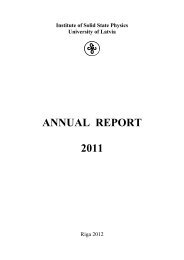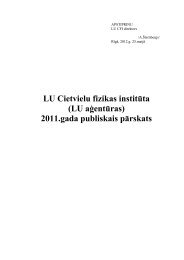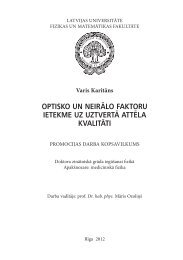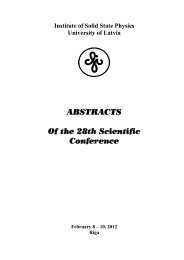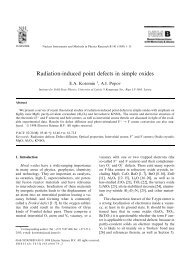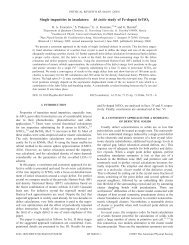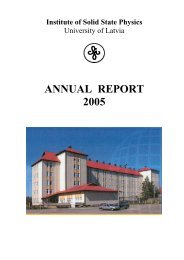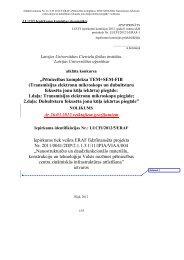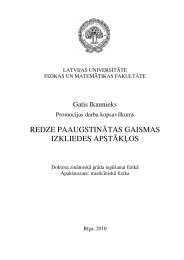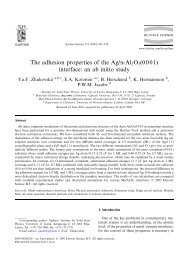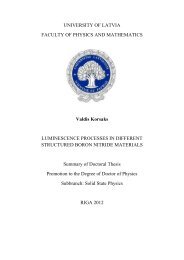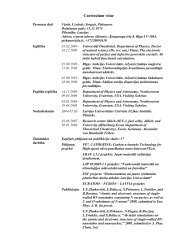Annual Report 2012 - Latvijas Universitātes Cietvielu fizikas institūts
Annual Report 2012 - Latvijas Universitātes Cietvielu fizikas institūts
Annual Report 2012 - Latvijas Universitātes Cietvielu fizikas institūts
You also want an ePaper? Increase the reach of your titles
YUMPU automatically turns print PDFs into web optimized ePapers that Google loves.
ABSORPTION AND LUMINESCENCE IN AMORPHOUS 95%SiO 2 5%GeO 2<br />
FILMS WITH FLUORINE FABRICATED BY SPCVD. IF GeODC(I) EXIST<br />
A.N. Trukhin, K.M. Golant 2 , J. Teteris 1<br />
1 University of Latvia, Solid State Physics Institute, LV-1063, Riga, Latvia<br />
2 Kotel’nikov Institute of Radio-engineering and Electronics of RAS,<br />
125009 Moscow, Russia<br />
We have studied influence of fluorine on germanium oxygen deficient luminescence<br />
center (GeODC) in films (~100 µm) produced by the surface-plasma chemical vapor<br />
deposition (SPCVD) without any consequent treatment, then corresponding to<br />
amorphous layer production at temperatures lower than temperature of glass softening.<br />
Two kinds of samples were studied: a sample with “high” concentration of fluorine and<br />
a sample with “low” concentration of fluorine. Main feature of the samples difference<br />
corresponds to difference in detection of GeODCluminescence. For the case of “high”<br />
level of fluorine a “normal” GeODC or so call GeODC(II) or twofold coordinated<br />
germanium is observable. That there is absorption band at 5 eVwere luminescence of<br />
GeODC is excited. In the case of low fluorine concentration the absorption band at 5 eV<br />
is not well expressed and however luminescence of GeODC is observed there under 248<br />
nm excimer laser (KrF) it intensity is much lower than in the case of high fluorine<br />
concentration. Most significant difference is observed for excitation with higher than 5<br />
eV photons – that is excitation with 193 nm (ArF) and 157 nm (F2) of excimer lasers.<br />
The decay kinetics of luminescence for observed under these conditions is very different<br />
from usual GeODC, however luminescence bands positions are close to usual GeODC.<br />
Noticeable effect under both last case of excitation is luminescence intensity growth<br />
during long time excitation (half an hour and more), therefore it was concluded that<br />
GeODC are produced by this irradiation.<br />
In the case of “high” concentration of fluorine the yield of GeODC luminescence excited<br />
with 157 nm photons (F2 excimer laser) still be high and the absorption in the range of<br />
such excitation is high. Then is was concluded that hypoteticalGeODC(I) does not exist<br />
at least in the produced samples. It is known from literature that SiODC(I) of pure silica<br />
glass could be passivated with fluorine with strong diminishing of famous 7.6 eV<br />
absorption band of oxygen deficient pure silica glass.<br />
18 O-LABELED INTERSTITIAL OXYGEN MOLECULES AS PROBES TO<br />
STUDY REACTIONS INVOLVING OXYGEN-RELATED SPECIES IN<br />
AMORPHOUS SiO 2<br />
K.Kajihara, L.Skuja, H. Hosono<br />
(a)<br />
Institute of Solid State Physics, URiga, Latvia<br />
(b)<br />
Department of Applied Chemistry, Graduate School of Urban Environmental<br />
Sciences, Tokyo Metropolitan University, 1-1 Minami-Osawa,<br />
Hachioji 192-0397, Japan<br />
(c)<br />
Frontier Collaborative Research Center, Mail Box S2-13, Tokyo Institute of<br />
Technology, 4259 Nagatsuta, Midori-ku, Yokohama 226-8503, Japan<br />
(d)<br />
Materials and Structures Laboratory, Tokyo Institute of Technology, 4259 Nagatsuta,<br />
Midori-ku, Yokohama 226-8503, Japan<br />
Isotope labeling has been widely used to study reactions involving oxygen species in<br />
amorphous a-SiO 2 . This article briefly describes recent progress in 18 O labeling<br />
techniques to study reactions involving interstitial oxygen molecules (O 2 ), which is one<br />
of the most important excess oxygen species in a-SiO 2 . The primarily focus will be on<br />
the combination of the 18 O labeling with photoluminescence spectroscopy, which<br />
96



